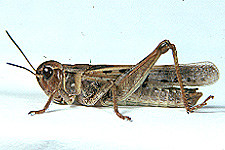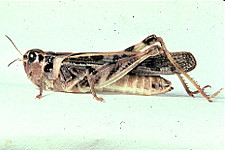Grasshoppers of Wyoming and the West
Entomology
Camnula pellucida (Scudder)
 |
 |
| Adult male | Adult female |
Common name - Clear-winged or Warrior grasshopper (Hantsbarger, 1979).
Geographic distribution - southern Canada, the western half of the United States and in northeastern United States. Distribution also extends south along the Appalachians as far as Virginia (Brooks, 1958). In Colorado it is found from the mountain foothills to the mountains above timberline (Hebard, 1929) and throughout western Colorado.
Habitat - short, thick grasses of damp meadowlands among hills and mountains. When the population increases, it sometimes moves to nearby grainfields, gardens and pastures (Bruner, 1897; Hebard, 1928).
Food habits - graminivorous, preferring western wheatgrass, Idaho fescue, smooth brome, Sandberg bluegrass, yarrow, carex, Junegrass, foxtail barley, needle grass, quackgrass and bluegrass; it sometimes eats bluegrass to the ground. These damaged areas are where aggregations are found during mating and oviposition (Anderson, 1964; Banfill and Brusven, 1973; Brooks, 1958; Criddle, 1933b; Hewitt, 1977; Mulkern et al., 1964).
Eggs - 25 to 30 light brown eggs per pod. Pods are not firmly cemented. Eggs are arranged in two columns. Average egg length, 4.7 mm: average diameter, 1.5 mm (Blatchley, 1920; Bruner, 1897; Onsager and Mulkern, 1963).
Nymph - five instars (Parker, 1924).
Adult - small to medium size. General color is yellowish to dark grey-brown. Face is almost
vertical. Vertex is rounded. Antennae are slender, yellow at the base, with the remainder
dark. Behind the eye is a dark triangular spot. Dorsal posterior margin of pronotum
forms an obtuse angle or right angle, and the median carina is slightly notched. The
lateral lobes of the pronotum have a dark vertical, oblong spot. Two amber lines extend
along the tegmina and converge in a "V" when the tegmina are closed. Tegmina have
round or oval splotches. Wings are clear. Male length, 20 mm; female, 25 mm (Blatchley,
1920; Hantsbarger, 1979).
Flight is direct, low and short; sometimes rustling and sometimes silent (Blatchley,
1920).
Oviposition - the grasshoppers gather on unplowed land by crop edges, pastures, ditch banks or small, overgrazed pastures. They quickly eat the grass and mate. Eggs are deposited below the soil surface in crowns of short bunchgrass. Eggs are produced every eight to 14 days (Blatchley, 1920; Bruner, 1897; Criddle, 1933b; Shotwell, 1941).
Seasonal history - overwinters in the egg stage with hatching occurring in early spring. Nymphs are not common after mid-July. Adults are present from late June to late August (Bruner, 1897; Newton et al., 1954).
Migratory tendencies - nymphs may migrate in swarms. Adults may take flight in swarms but do not migrate long distances (Ball, 1942).
Abundance and importance - common at higher altitudes in Colorado (Caudell, 1903). It may move into cultivated areas and cause serious damage to vegetables and other crops, especially grain. Range grasses are its most important food (Ball et al., 1942).
C. pellucida fact sheet from the Field Guide to Common Western Grasshoppers
Next Species: Ceuthophilus and related spp.
Previous Species: Brachystola magna
Biology of Common Colorado Grasshoppers List
Biology of Common Colorado Grasshoppers
Grasshoppers of Colorado Contents

